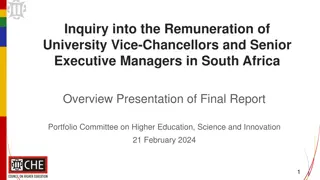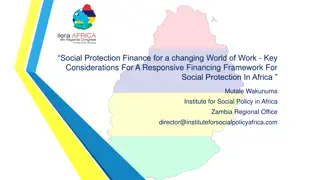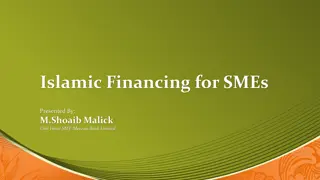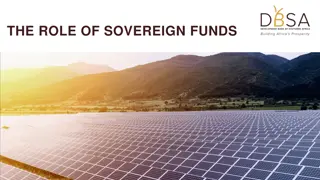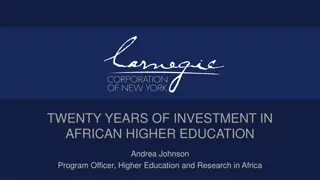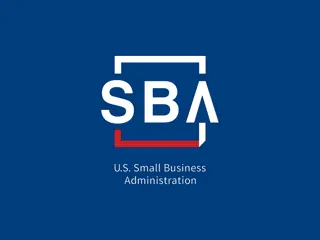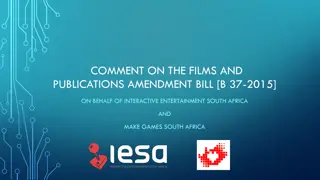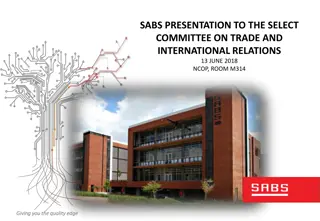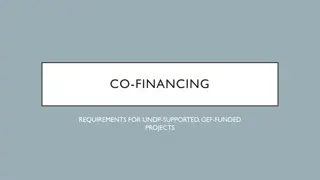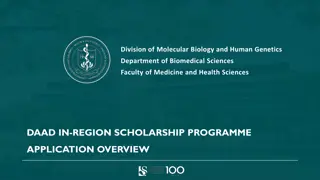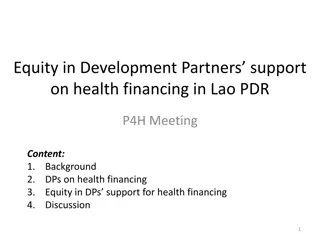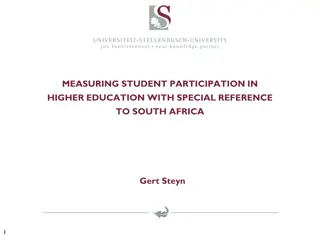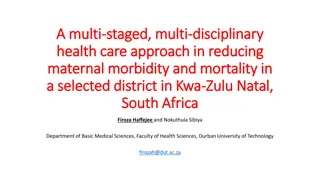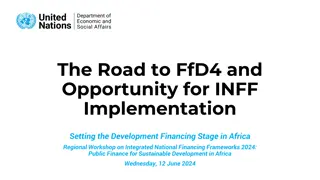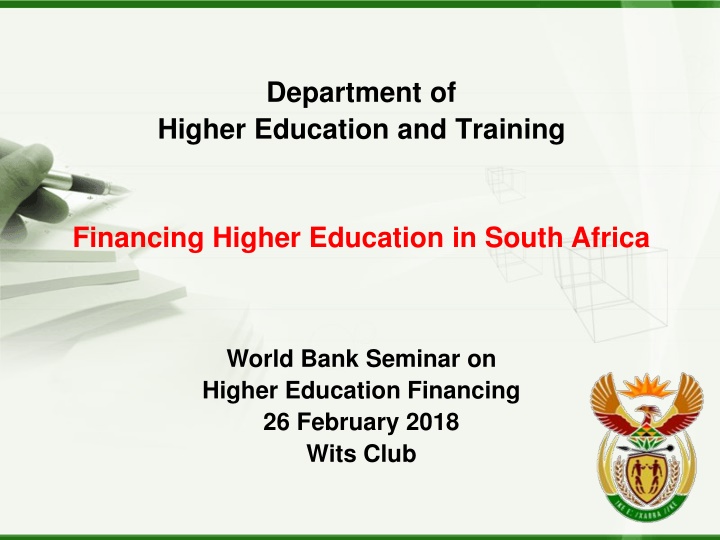
Financing Higher Education in South Africa: Insights and Policies
The funding models and policies shaping higher education financing in South Africa. From the right to education to the sharing of costs between public and private stakeholders, discover the approaches and principles guiding the investment in higher education institutions and students. Learn about the government's commitments to ensuring access to education for all students, including the poor and working class, through schemes like the National Student Financial Aid Scheme (NSFAS) and financial solutions for the missing middle students.
Uploaded on | 0 Views
Download Presentation

Please find below an Image/Link to download the presentation.
The content on the website is provided AS IS for your information and personal use only. It may not be sold, licensed, or shared on other websites without obtaining consent from the author. If you encounter any issues during the download, it is possible that the publisher has removed the file from their server.
You are allowed to download the files provided on this website for personal or commercial use, subject to the condition that they are used lawfully. All files are the property of their respective owners.
The content on the website is provided AS IS for your information and personal use only. It may not be sold, licensed, or shared on other websites without obtaining consent from the author.
E N D
Presentation Transcript
Department of Higher Education and Training Financing Higher Education in South Africa World Bank Seminar on Higher Education Financing 26 February 2018 Wits Club
The Right to Education Section 29 of the Constitution: (1) Everyone has a right (a)to a basic education, including adult basic education, and (b) further education, which the state, through reasonable measures, must make progressively available and accessible. basic education (adult basic education) - a fundamental right further education (HE and TVET) - a secondary right to be made available and accessible to those who merit it Make available = provide sufficient spaces for study Make it accessible = affordable; no academically deserving individual should be denied access on the basis of financial need 15
Funding Higher Education Institutions and Students WP 3: A Programme for the Transformation of Higher Education recognised HE as both a public and a private good: Investment in higher education important for economic development of the country; but knowledge and skills acquired from achieving a university qualification result in significant lifetime private benefits for successful students WP 3 principle: costs for HE should be shared between public and private beneficiaries BUT finances should not prohibit academically deserving students from accessing HE 21
Three streams of income to finance public HE Costs of higher education shared between public and private interests the state in the form of subsidies the private sector, through investments in research, scholarships etc. and families themselves, whose children will have access to the private goods of productive engagement in the economy by virtue of their access to higher education Three funding streams: First stream (direct subsidies from DHET) Second stream (student fees) Third stream (funding from donors/ research funding/ other income from investments, beneficiation of intellectual property etc, including from government departments other than the DHET) 4
Funding Higher Education Institutions and Students White Paper on Post School Education and Training: affirmed the cost sharing model for HE Committed government to strengthen the National Student Financial Aid Scheme (NSFAS) and fully fund poor and working class students to access and succeed in HE Committed government to find a solution for funding so called missing middle students The WP on PSET is in line with the NDP which indicated that by 2030 all students qualifying for NSFAS must be provided access FCS funding (loans and/ bursaries); students who do not qualify for NSFAS should have access to bank loans, backed by state sureties; and, both the NSFAS and bank loans should be recovered through arrangements with the South African Revenue Service. 21
Funding public Higher Education First stream Income is distributed through a performance based funding framework to public higher education institutions Three steering mechanisms: planning, funding and quality assurance Planning based on enrolments (headcounts/ FTEs); infrastructure planning; planning for development Subsidies distributed in the form of a block grant and earmarked grants 21
Funding Higher Education (2018/19) Teaching input grant Block Grant (discretionary) 75% of budget Teaching output grant Research output grant Earmarked grants (steer transformation) 25% of budget Institutional Factor University Capacity Development New Universities Grant Veterinary Sciences Grant Foundation Provisioning HDI Clinical Training Grant Infrastructure and Efficiency SMU operational grant Development Grant 22
Other Higher Education Funding Other Earmarked Grants NSFAS NIHSS AIMS Sector planning, monitoring, evaluation and support programme (oversight) Council on Higher Education 22
Funding Public Universities Comparison of university income sources 2000 and 2014 Higher Education Income Sources (ZAR Billion) 100% Third Stream R17 (28.6%) Third Stream R8.78 (27%) 90% 80% Second stream: Fees R7.80 (24%) Second stream: Fees R19.6 (32.9%) 70% 60% 50% 40% First stream: Government R15.93 (49%) First stream: Government R22.9 (38.4%) 30% 20% 10% 0% 2000 2014 Source: Data collected from University Annual Reports (2000 and 2014) and DHET financial analysis reports 9
Funding Public Universities Block grant allocation to universities increased by 139.7% between 2004/05 and 2015/16 in nominal terms BUT eroding effect of inflation (at CPI) = 29.8% growth in real terms student enrolment growth over the period = a net decrease in the per capita Full Time Equivalent (FTE) student allocation of - 3.4% If HEPI (CPI +2%), then the 139.7% nominal increase in the block grant from 2004/05 to 2015/16, translates into 5.6% in real terms, and a net decrease in the per capita FTE student allocation of - 21.4% 10
Tuition Fee Levels Differentiated Across the System Source: Data provided to the DHET by universities and signed off by their VCs, October 2015 12
Full Cost of Study Differentiated Across the System Source: Data provided to the DHET by universities and signed off by their VCs, October 2015 13
Student Debt Line item 2016 2015 2014 R 000 R 000 R 000 Student debt before provision for doubtful debt Provision for doubtful debt 8 378 243 7 037 451 6 188 464 -5 068 728 -3 890 986 -3 503 504 Net student debt 3 309 516 3 146 465 2 684 960 Student debt ratio: Tuition and accommodation fees 22 302 356 22 224 385 19 428 315 Student debt as a percentage of tuition and accommodation fees (before impairment) Student debt as a percentage of tuition and accommodation fees (after impairment) 37.6% 31.7% 31.9% 14.8% 14.2% 13.8% 14
Providing Student Financial Aid Government, through NSFAS, had been progressively implementing fee-free higher education for the poor (up until 2017): a student entering university is provided with an interest free loan to cover their tuition (and potentially) FCS while studying. interest kicks in one year after successful completion The interest is significantly below the commercial lending rate. 60% of the loan is converted into a grant for students completing in minimum time. If the student never benefits from the goods of university education, i.e. they never find productive employment and remain poor, they never pay back their loan and in effect receive their entire university education free (paid for tax payers) BUT only available for the poor other financially needy excluded Insufficient funds to cover FCS for all who qualify 17
Heher Commission on HET Established by the President to look at the feasibility of providing free higher education and training in Jan 2016 Reported in August 2017 confirming the cost sharing model for hunger education and recommending, amongst a range of other things, a universal income contingent loan scheme for students to access university education Government remained committed to providing free higher education for the poor and working classes, did not accept the ICL scheme suggested by the commission and announced fully subsidised free higher education for poor and working class students to be introduced over a 5 year period from 2018 academic year (estimated at 40% of students in HE) Also to increase baseline subsidy funding to HE institutions form 0.68% of GDP to 1% of GDP over 5 years. 18
Funding support for student fees Free full cost of study for students from families with household incomes up to R350 000 per annum (poor and working class) = actual cost of tuition + learning support materials (agreed minimum package) + subsidised accommodation/ transport Ministerial Committee on funding poor and missing middle students Pilot of a new funding model including grants and income contingent loans though a PPP 19
Setting fees for Public Universities A regulatory framework for setting fees in higher education to be developed to ensure affordable fees and sustainable institutions ( built on advice received form the CHE); implies a change from individual institutions setting fees in line with own requirements 20
Funding Public Universities Budget totals for the university sector Increase in budget from previous financial year Budget category 2016/17 (R'000) 21 678 098 13 753 540 1 225 710 3 512 017 3 186 831 6 246 374 2 422 013 2017/18 (R'000) 25 322 874 16 220 201 1 445 538 4 310 654 3 346 481 8 701 418 2 541 903 2018/19 (R'000) 29 023 192 18 604 961 1 659 576 4 936 259 3 822 396 9 516 877 2 688 063 2019/20 (R'000) 31 916 694 20 450 237 1 829 773 5 436 359 4 200 325 10 261 899 2 838 594 2017/18 2018/19 2019/20 1 Block grants for universities 1.1 Teaching inputs 1.2 Institutional factors 1.3 Actual teaching outputs 1.4 Actual research outputs 2 Earmarked grants for universities 2.1 Infrastructure & output efficiencies 2.2 New universities Capital funds (SPU & UMP) Operational funds (SPU & UMP) NIHE Northern Cape Pipeline Students Health Sciences Operational (SMU) 2.3 University Capacity Development Teaching Development Research Development 2.4 Foundation Provision 2.5 Clinical Training of Health Professionals 2.6 HDI Development Grant (8 universities) 2.7 Veterinary Sciences 2.8 MBChB students 2.9 Interest & redemption on historic loans 2.10 Zero percent student fee increase 2.11 Gap grant for poor & missing middle student fees 16.8% 17.9% 17.9% 22.7% 5.0% 39.3% 5.0% 14.6% 14.7% 14.8% 14.5% 14.2% 9.4% 5.8% 10.0% 9.9% 10.3% 10.1% 9.9% 7.8% 5.6% 974 736 290 429 10 000 978 482 360 736 6 500 1 000 542 555 593 1 044 365 680 125 0.4% 24.2% -35.0% 2.3% 54.0% -100.0% 4.4% 22.4% 0 0 100 000 945 000 200 000 997 920 100.0% 5.6% 0 225 000 510 000 165 000 335 794 475 026 454 992 156 638 27 900 3 647 320.0% -100.0% -100.0% 9.6% 20.9% 5.8% 5.8% -40.1% -100.0% -4.5% 649 596 209 547 319 956 452 406 433 532 149 250 30 700 4 209 300 000 0 0 0 0 -21.5% -21.3% 5.0% 5.0% 5.0% 5.0% -9.1% -13.4% 368 068 574 334 481 382 165 723 16 700 3 484 388 454 650 722 508 339 175 000 5.5% 13.3% 5.6% 5.6% 0 3 313 -4.9% 0 0 0 0 2 459 800 2 617 988 2 775 067 6.4% 6.0% 3 Grants to institutions 3.1 NSFAS - Cape Town 3.2 Institute for Human and Social Sciences 3.3 African Institute for Mathematical Studies 4 Sector oversight 4.1 Sector Planning, Monitoring, Evaluation & Support TOTAL 8 924 157 8 893 811 25 081 5 265 10 000 10 000 36 858 629 9 881 270 9 849 421 26 323 5 526 10 500 10 500 43 916 062 14 945 950 14 901 269 38 837 5 844 13 109 13 109 53 499 128 24 069 519 24 023 952 39 396 6 171 13 731 13 731 66 261 843 10.7% 10.7% 5.0% 5.0% 5.0% 5.0% 19.1% 51.3% 51.3% 47.5% 5.8% 24.8% 24.8% 21.8% 61.0% 61.2% 1.4% 5.6% 4.7% 4.7% 23.9% 21
Throughput rate in undergraduate programmes (contact: after year 6; distance: after year 10)
Affordable HE for All and sustainability of public HEIs Improved government funding (block grant) to the university system to enable growth and keep fees in check (to 1% of GDP by 2022/23) Universities must become more efficient in utilising the funding in the system including finding mechanisms to improve partnerships and sharing resources across the system, improve internal efficiencies in operations, improve student success; ensure less wastage New technologies, data analytics and student advisory services 0pen learning; distance and blended learning (BUT pedagogy to ensure success) Central Applications Service (one stop shop better placement and career advice) Improved private sector investment (in student bursaries especially for PG students, research & innovation) Student financial aid extended to include all who need it (grants and loans); a regulatory framework for setting fees for higher education 23

